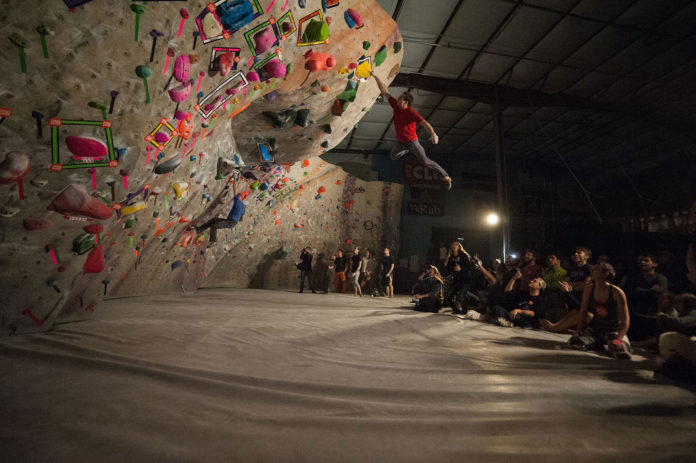Competition setting is more than just putting up flashy moves, and everyday route turnover goes beyond a balanced spread. In this Ask a Setter, Louie Anderson identifies key similarities and differences between setting for local comps, bouldering leagues, and regular turnover in a gym. Across all three responsibilities, the devil’s in the details, and knowing your audience will help you dial them in.
Got a routesetting question you’d like answered? See if we’ve covered it already in a past Ask a Setter, and then email us your question here.
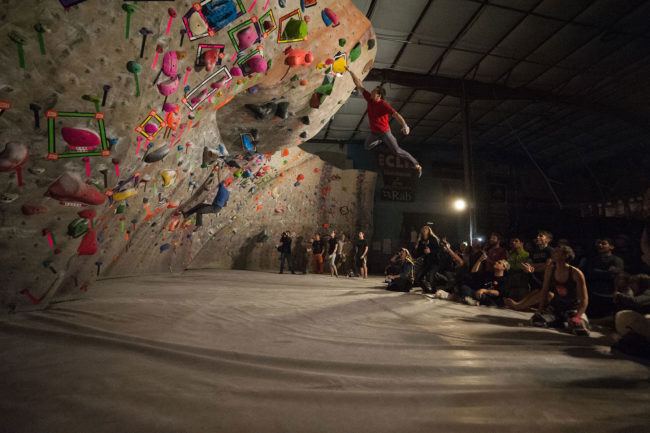
QUESTION: How is routesetting different for a locals comp, a bouldering league, and the usual gym turnover? Any specific tips?
The setting focus for all these scenarios can vary slightly, but there are also similarities. Regardless of which purpose you’re planning to set for, special attention should be placed on understanding the climbing levels and styles of your customer base and the competitors coming to the event. Knowing your audience more fully will allow you and your team to set appropriate challenges for the intended user groups, and will allow for a greater involvement with, and satisfaction within, your clientele.
We will talk more specifically about each situation below, but in general the setting focus for all of them should always include diverse climbing challenges, a good blend of aesthetic variety, and some attention to making the climbing accessible to all climbers.
Regular Gym Setting
A good setting team understands the facility’s customer base. This not only includes the climbing levels that climbers in the gym regularly succeed on, but also their interest in training, learning new styles, or pushing themselves on harder challenges. Based on this information, a disbursement plan can be created that suggests how many climbs of each grade or circuit could be set in the gym at any given time. This plan will usually have fewer climbs in the lowest and highest grades, and more climbs at the levels where most of the gym users spend the majority of their climbing time. These levels will vary from facility to facility, but the peak of the bell curve on the plan will usually fall around V4 or 5.10+/11-.
When first creating this setting plan, it’s important to monitor climber trends, solicit feedback, or otherwise check to see how appropriate the plan is. You can then make adjustments as needed. Oftentimes, gyms that have multiple training boards and equipment will opt to set fewer harder climbs on their walls. This strategy can sometimes be acceptable, but make sure that climbers are actually using the training options, and would not rather see more challenging climbs set also.
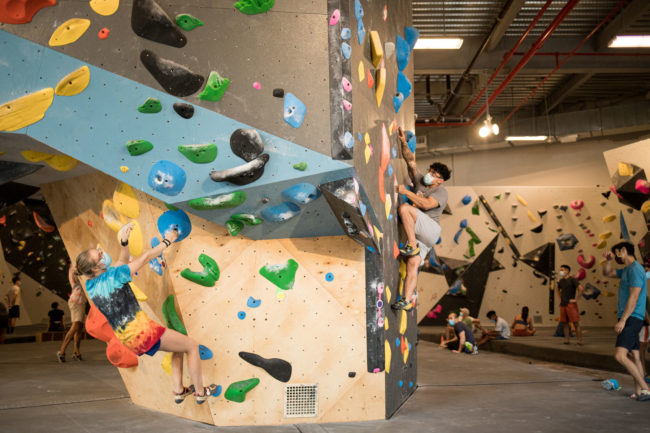
In general, I like to see a very diverse offering of climbs. This can include diversity in movement styles, hold types, crux styles (single crux, sustained climbing, multiple short cruxes, and differing RIC scale values), wall angles used, etc. Climbs at all levels will ideally be set all around the gym and include all options in these categories. The goal should always be to provide the facility’s climbers with the most diverse experience―regardless of their climbing level or current strengths.
When looking at everyday gym setting, there should also be a focus on accessibility. For example, no one size of climber (short or tall) should have undue advantages or struggles due to their size, which is especially pertinent when setting for children. This is not to say that every climb needs to be equitable. I believe that having reachy, scrunchy, or other types of climbs can often provide challenges that help climbers grow and progress into different styles of climbing than they might otherwise be exposed to or develop skills in. Unless your gym is very small, it’s perfectly acceptable to have outliers that do not appeal to everyone visiting the facility. But it is important that most climbs in a gym are fair and equitable; having 80% of the climbs falling into this category is a standard goal across the industry.
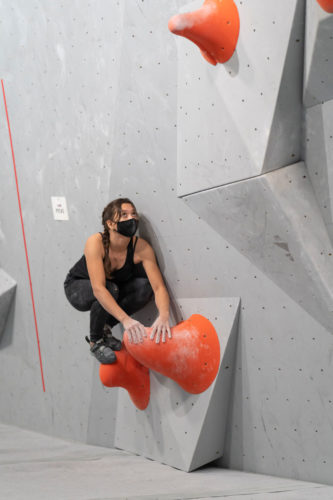
Bouldering Leagues
Since there are generally fewer problems involved in each session or round of a bouldering league than usual gym turnover, it’s even more important to ensure that you are providing a good diversity of climbing challenges for the participants. Different leagues are set up differently, and I would encourage you to try and do something unique with yours to set it apart and make it appealing to the broadest number of climbers as possible. Bouldering leagues often present a great opportunity to draw climbers from surrounding gyms and spark interest in your facility. If those climbers like what they climb on, it’s entirely feasible that some of them may become members at your gym as a result.
When planning your league’s “season,” there are a few ways to approach things. If your season only spans a short number of sessions, then you’ll probably need to keep the climbing proposals diverse and representative of the cross section of climbers participating. Conversely, if your season is a long one, you may be able to play with themed sessions, where a particular set might focus on specific styles of climbing (i.e., dynos, compy coordination problems, volume-heavy challenges, or super techy boulders). When doing this, it’s generally best to not give advance warning of what climbers should expect, as an added challenge. This approach takes the focus off of specific sessions, and shifts it even more than normal to a team’s performance over the entire season and a variety of intensified stylistic sessions.
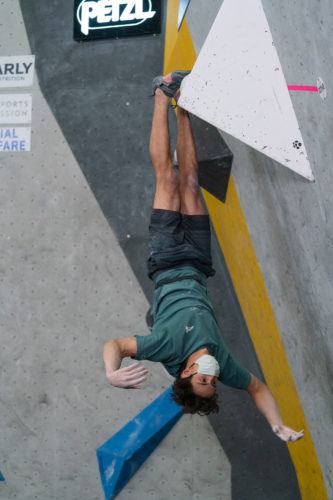
Because league sessions will usually involve a limited number of problems, extra focus should be given to making the problems accessible and equitable for all sizes and groups of climbers. Remember also that these considerations do not just apply to height or reachiness, but also to elements such as hold radius sizes, specifically with regards to pinches and less positive holds.
In general, bouldering leagues are a great way for groups of friends to come together in a friendly competitive environment. Oftentimes the participants are climbers who may not normally compete in a more formal competition event. Because of this it’s important to keep the mood light and fun. Consider doing something cool and unique with the hold patterns, signage, or the styles of climbing you propose.
Additionally, league sessions are often a good time to introduce competition-style problems that folks might not normally be exposed to. The climbing could be slightly more progressive in difficulty than what your team might normally set, and can start to introduce slightly more complex challenges across the board. If your league sets different problems for different difficulty categories, it’s very important to nail down the grades and make sure there’s a good progression between different grades and categories. This is especially the case if you allow climbers to try problems outside their category.
A final thought on bouldering leagues is that their primary focus is usually on building community and providing a competitive environment in a more light-hearted way than a local competition event. With most setting considerations, the bouldering league standards and goals will fall somewhere between regular gym setting and competition setting. While you still want to see separation of successes across the different climbers and teams, this separation will come from the entire session or season of problems, instead of from a much smaller sampling of problems in a local competition.
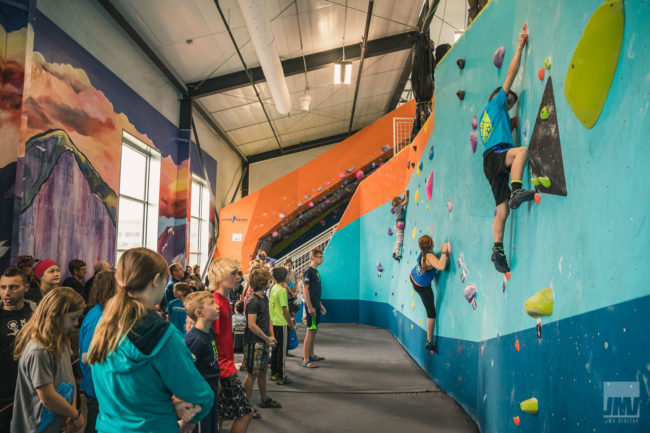
Local Competitions
When setting for a local competition, it’s vitally important that the Head or Chief Setter understands the ability levels of the different climbers expected to participate. This understanding will help ensure that the team has set appropriate difficulty levels for the competition’s different categories on the big day.
The primary goal in these events is to separate climbing performances across each category to determine the winners in each one. The best way to achieve this objective is to propose vastly varied challenges to test the competitors. The climbing should be somewhat more progressive than that found in bouldering leagues, and there should be multiple fall points along the length of the climb. The climbs should also present different hold types, movement styles and wall angles across a given round, in order to test as many different facets of climbing mastery as possible. In a perfect event, the winner will be the one who has succeeded across several different styles of climbing, rather than the climber who is really good at just one or two styles.
Because there are usually far fewer climbs involved in a competition, it’s even more important to have an awareness of accessibility and fairness in the setting you put on the wall. Primarily, the climbs should be equitable to all sizes of climbers in a given category. Knowing your competitive field will help you better understand the size ranges you’re setting for. As mentioned earlier, this is particularly important when setting for youth climbers, since there is often a wide range of heights in a single category.
The current trend of competition setting includes a lot of coordination, presses, and jumpy movement. By all means these events provide an opportunity to set those styles, as the density of holds on the walls are generally much lower. Remember too, though, to include other challenges and movement styles. As said above, we want to determine the best all-around climber, not just the one who has mastered these “comp-style moves.”
Often the focus in competitions will be on the better climbers in the Open category, but care should be taken to allow for a similar level of focus when setting for the Recreational, Intermediate and Advanced categories as well. These climber groups are often much more representative of your gym’s usual clientele, and this event is an opportunity for them to shine as brightly as the strongest climbers in the region. Make sure to give them flashy climbs too, and an expertly set round that’s fair and fun.

Louie Anderson has been climbing since 1974 and routesetting for over 35 years. He’s a big proponent for education in the setting world, having written The Art of Coursesetting (re-released as Fundamentals of Routesetting). Anderson has also been shaping holds and consulting for gyms for decades. His holds are available at Legacy Ascension, and more information about his services is at louieandersonclimbing.com.
Listen to our podcast with Louie: Revitalizing Routesetting for the Next Generation




